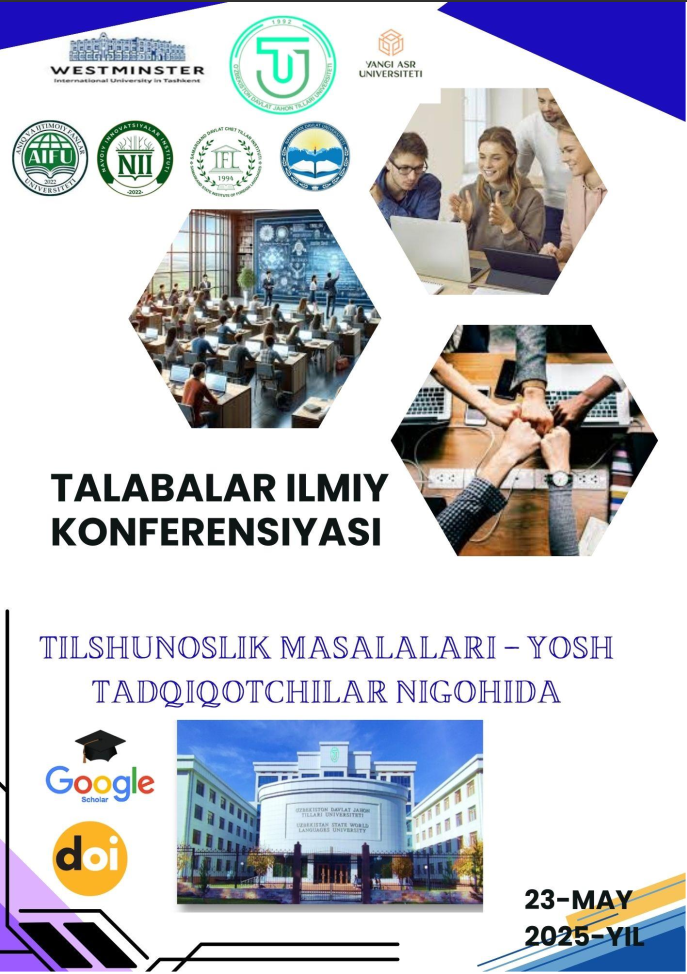SEMANTIC MAPPING OF METONYMIC TRANSFERS IN ENGLISH AND UZBEK
https://doi.org/10.5281/zenodo.15517384
Kalit so‘zlar
Discourse connectives, pragmatics, cohesion and coherence, cross-cultural communication, speaker stance, politeness strategies, contrastive linguistics, contextual meaning, semantic relations, pragmatic markers, turn-taking, formality and register.Annotasiya
Discourse connectives are essential linguistic elements that contribute significantly to the coherence, cohesion, and overall interpretability of both spoken and written communication. They serve as bridges between sentences and ideas, guiding listeners or readers through the flow of discourse. However, their role extends beyond syntactic linkage they function as powerful pragmatic tools that signal speaker intent, manage interpersonal relationships, convey politeness, and reflect cultural norms. This article investigates the pragmatic functions of discourse connectives in the English and Uzbek lexicons through a comparative linguistic and pragmalinguistic lens.
Foydalanilgan adabiyotlar ro‘yhati
Abulkasimovna, E. Z., & Leonidovna, M. N. (2023, March). THE LEXICAL-SEMANTICAL USAGE OF PROFESSIONAL LEXEMES IN “UTGAN KUNLAR”(" PAST DAYS") BY ABDULLA QADIRI. In International Scientific and Current Research Conferences (pp. 20-22).
Akhmedova, Z. (2018). “Contextual use of discourse particles in Uzbek oral speech.” Uzbek Journal of Language Studies, 3(2), 44–51.
Ashirova, X., & Mamatkulova, F. (2024). Applying different teaching methods for enhancing the reading skills of elementary learners. O ‘zbekiston davlat jahon tillari universiteti konferensiyalari, 155-160.
Buranova, D. D. (2007). O‘zbek tilining hozirgi zamon uslubiy tizimi. Toshkent: O‘zMU.
Erdanova, Z. (2019). Onomastic is a mirror culture. In Science and practice: a new level of integration in the modern world (pp. 149-152).
Eshonqulov, J., & Sultonova, M. (2025). DIGITAL MEDIA AND COPYRIGHT: LEGAL DISPUTES AND AGREEMENTS. International Journal of Artificial Intelligence, 1(2), 1149-1154.
Fraser, B. (1999). What are discourse markers? Journal of Pragmatics, 31(7), 931–952.
Halliday, M. A. K., & Hasan, R. (1976). Cohesion in English. London: Longman.
Kupaysinovna, S. G. (2020). THE ROLE OF ENGLISH TEACHER IN A MODERN CONTEXT. Проблемы науки, (7 (55)), 64-65.
Kupaysinovna, S. G. (2021). The importance of learning vocabulary in speaking English. Проблемы науки, (6 (65)), 92-94.
Rashidova, G., & Fariza, N. (2024). THE RELATIONSHIP BETWEEN LANGUAGE AND CULTURE. TANQIDIY NAZAR, TAHLILIY TAFAKKUR VA INNOVATSION G ‘OYALAR, 1(3), 93-95.
Rashidova, G., & Munira, I. (2025). THE IMPACT OF TECHNOLOGY ON LANGUAGE DEVELOPMENT. TANQIDIY NAZAR, TAHLILIY TAFAKKUR VA INNOVATSION G ‘OYALAR, 1(4), 151-154.
SULTONOVA, M. (2024). On the issue of critical thinking.
Zakhitovna, M. P. (2023). THE IMPORTANCE OF PRINCIPLES IN TEACHING ENGLISH TO DIFFERENT AGE GROUPS. European International Journal of Pedagogics, 3(06), 85-87.

